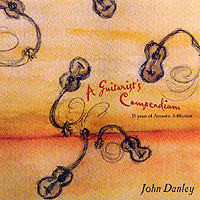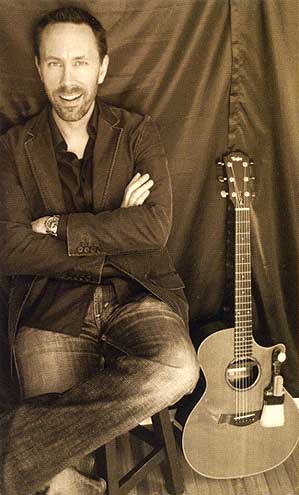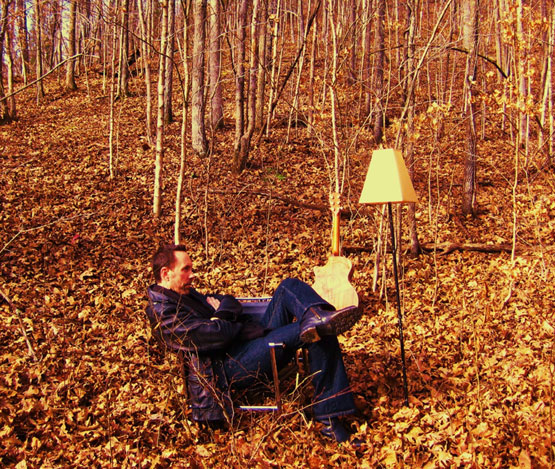 One
of the hardest working acoustic guitar players in Nashville, John
Danley puts his musical history in order with a 25 track best of compilation
entitled A Guitarist’s Compendium: 15 Years Of Acoustic Addiction.
Filled with an infectious acoustic guitar groove that spans a
wealth of musical genres—from folk to whimsical, spot-on acoustic
jazz—the CD brings together 25 tracks of finger-style guitar
music written and recorded by the guitarist between 1995 and 2010.
Danley’s 2009 solo CD release, Acoustic Dimorphism was
heralded as one of the top acoustic guitar albums of the decade, and
A Guitarist’s Compendium offers yet another opportunity
to glimpse the talent and technique Danley has brought to the guitar
world over the past decade and a half. The cover painting by Lori
Anne Parker is exquisite while liner notes by Danley touch upon
highlights of his vital musical history—including the fact that
the 25 track CD is not presented in any kind of chronological history
yet, start to finish still sounds thoroughly connected.
One
of the hardest working acoustic guitar players in Nashville, John
Danley puts his musical history in order with a 25 track best of compilation
entitled A Guitarist’s Compendium: 15 Years Of Acoustic Addiction.
Filled with an infectious acoustic guitar groove that spans a
wealth of musical genres—from folk to whimsical, spot-on acoustic
jazz—the CD brings together 25 tracks of finger-style guitar
music written and recorded by the guitarist between 1995 and 2010.
Danley’s 2009 solo CD release, Acoustic Dimorphism was
heralded as one of the top acoustic guitar albums of the decade, and
A Guitarist’s Compendium offers yet another opportunity
to glimpse the talent and technique Danley has brought to the guitar
world over the past decade and a half. The cover painting by Lori
Anne Parker is exquisite while liner notes by Danley touch upon
highlights of his vital musical history—including the fact that
the 25 track CD is not presented in any kind of chronological history
yet, start to finish still sounds thoroughly connected.
MWE3 PRESENTS AN INTERVIEW WITH
JOHN DANLEY
 MWE3:
Would you say the 2011 CD release of A Guitarist's Compendium
offers a good overview of your career to date and what did you want
to set out to say with this collection?
MWE3:
Would you say the 2011 CD release of A Guitarist's Compendium
offers a good overview of your career to date and what did you want
to set out to say with this collection?
JOHN DANLEY: As I alluded to in the liner notes, this compilation
was put together in an attempt to represent a wide range of pieces
similar to the variety of acoustic music performed during a live concert.
What I really wanted to do was buffer a mid-life crisis while holding
on to the last vestiges of my youth. In retrospect, I realized how
many years were spent emotionally attached to the outcomes of a custom
designed amalgam of premium wood grains. I suppose this recording
could be considered an audio memoir of sorts—fifteen years of
writing and performing obscure, noncommercial, instrumental guitar
music. In some ways I feel as though I've lived vicariously through
these tunes. There is a detached yet existential awareness that a
great deal of my life has been spent documenting melodic patterns.
MWE3: In what ways has being an "eclectic" acoustic guitarist
helped your career and how would you describe the term eclectic as
you use it to describe your own music and guitar style as presented
in the Compendium CD?
JD: Pathological diversity appears to work best in live performance
scenarios. However, most individuals and critics prefer albums to
be thematic with a sense of calculated flow. One of my favorite synonyms
for “eclectic” is “multifarious.” Objectively
speaking, I couldn’t help but notice how much I vacillate between
traditional guitar music that sounds indigenous to the Southeast and
ballads that have their roots in European traditions. The contrast
of Southern geographical influence versus my proclivity for the cultural
values of Europe has resulted in a schizophrenic musical juxtaposition.
I would say that being eclectic has made it difficult to stylistically
identify my playing.
MWE3: What were the parameters in choosing the tracks for the Compendium
CD, as far as representing the different eras and times of your career
and can you say something about a couple of your favorite recordings
or albums featured on the collection?
 JD: I have
no brand loyalty concerning particular tunes. My selection for this
compilation was based on a combination of audience requests, various
anecdotes about my music from listeners, consistent reactions to particular
pieces, etc. The irony remains that the compositions I have labored
most intensely over are often overlooked in favor of songs that evolved
via serendipitous accidents. This phenomenon has reminded me to pay
closer attention to the nature of spontaneity while remembering not
to dismiss ideas that come easily. One of the liabilities of musical
experience is the tendency to over think details. As Bob Kaspar used
to say about highly abstract music, “It looks better than it
sounds.” Sometimes, in an attempt to please themselves, musicians
abandon the principle of simplicity. In either direction there exists
a law of diminishing return. Nonetheless, with a few exceptions, most
of my music has maintained a mellifluous pattern structure (perfect
authentic cadence) and this album focuses on the more accessible melodies.
My favorite album, for personal reasons, is Drifting Into Oblivion.
JD: I have
no brand loyalty concerning particular tunes. My selection for this
compilation was based on a combination of audience requests, various
anecdotes about my music from listeners, consistent reactions to particular
pieces, etc. The irony remains that the compositions I have labored
most intensely over are often overlooked in favor of songs that evolved
via serendipitous accidents. This phenomenon has reminded me to pay
closer attention to the nature of spontaneity while remembering not
to dismiss ideas that come easily. One of the liabilities of musical
experience is the tendency to over think details. As Bob Kaspar used
to say about highly abstract music, “It looks better than it
sounds.” Sometimes, in an attempt to please themselves, musicians
abandon the principle of simplicity. In either direction there exists
a law of diminishing return. Nonetheless, with a few exceptions, most
of my music has maintained a mellifluous pattern structure (perfect
authentic cadence) and this album focuses on the more accessible melodies.
My favorite album, for personal reasons, is Drifting Into Oblivion.
MWE3: With the release of the Compendium CD describe how your
sound and/or approach to recording / composing has changed or evolved
since Postponing The Worm back in 1997 through to the CD release
of your 2009 Acoustic Dimorphism album?
JD: A copious amount of my earlier work was coupled with a sense of
urgency. Postponing The Worm was recorded on half inch inch
reel-to-reel tape during a single weekend. Before the digital era
was in full-swing, getting through a piece of music without making
egregious errors was the best tactic for saving money. Consequently,
my first two recordings sound rushed and intervals of silence, dynamics,
and overall negative space were sacrificed for the sake of accuracy.
Nonetheless, some prefer what I can only describe as “high-anxiety”
guitar playing.
The emancipation resulted from learning how to produce home recordings
a la Cemeteries, Missed Trains, & Blue Skies (2003).
The initial learning curve was worth the effort in terms of being
able to take time and create ambiance while respecting tempo. The
real benefit of digital is being able to do multiple takes during
a single sitting without rewinding tape. However, I treat digital
the same way I would a 4-track recording—there is no cut and
paste or post-production editing. Each melody is recorded separately
from start to finish and chosen based on the best take. One could
say I’m a digital purist, but the ironic humor of that statement
would be too risible to defend.
I still write and record technically anxious, high-energy guitar music,
but now the tempo is less relative. In addition, my ballads are much
more “open” and nonlinear. Learning how to make high-quality
home recordings, in my opinion, is the most important practical skill
a musician can develop.
MWE3: How many different guitars are actually featured on the cross-section
of tracks on the collection and how has your choice of guitars changed
over the years? What guitars are you using most these days and how
about strings and or new studio gear currently being used?
 JD: Taylor
guitars have always been a standby for me. I have used a variety of
512s and 714s in the studio. Other guitars include a Lowden 010 and
the occasional nylon. The oddest instrument I’ve recorded with
was a gourdalin, as featured on “Etude” from Drifting
Into Oblivion. My current guitar is a limited edition Taylor 714—cedar
top with grafted walnut back and sides. Regarding strings, Audio Electric
Research produced a wonderful phosphor bronze string that has, unfortunately,
been discontinued. In my opinion, Elixir is the only comparable brand
that can withstand humidity and structural violence.
JD: Taylor
guitars have always been a standby for me. I have used a variety of
512s and 714s in the studio. Other guitars include a Lowden 010 and
the occasional nylon. The oddest instrument I’ve recorded with
was a gourdalin, as featured on “Etude” from Drifting
Into Oblivion. My current guitar is a limited edition Taylor 714—cedar
top with grafted walnut back and sides. Regarding strings, Audio Electric
Research produced a wonderful phosphor bronze string that has, unfortunately,
been discontinued. In my opinion, Elixir is the only comparable brand
that can withstand humidity and structural violence.
In terms of new studio gear, I have been simultaneously annoying and
entertaining myself with an Electro-Harmonix POG2. It works surprisingly
well on acoustic guitar—but moderation is a virtue.
MWE3: As we fully enter the second decade of the millennium do you
have any hopes or aspirations as far as your music and/or the music
world in general? What would you like to do next musically?
JD: Since I have lived in Nashville for over a decade, I feel justified
when saying that the problem with today’s music “business”
is not a supply-side issue—it’s a demand-side travesty.
The economy of scarcity model that the industry has relied on for
years seems to have dissipated to a large extent, but the democracy
of the internet has demonstrated its own shortcomings via relativistic
ubiquity. Hard copy CDs have been eschewed in favor of single digital
downloads and YouTube reports over 35 hours of video being uploaded
every minute. The term “artist” has completely lost context
while the RIAA reports anywhere from 27,000 - 35,000 new releases
every year, just in the United States! In addition, there appears
to be no middle-class for working musicians. Economic outliers continue
to exist, such as the fact that Kenny Chesney retains a higher pre-tax
income per year than the combined revenue for the entire graduating
class of Juilliard during the last decade. Music venues and ticket
holders, spoiled by the exhibitionistic internet, have come to expect
world-class performances and unrivaled entertainment value for minimal
costs. If you synthesize these factors with a struggling economy,
the visual becomes quite dispirited.
In lieu of all the aforementioned situational dynamics, an unsentimental
realism can still be maintained while keeping the perspective that
creating art of any medium should be immune to the fluctuations of
social and economic circumstance. I have found that the visceral aesthetics
of composing, recording, and performing never disappear, regardless
of whether the value is purely recreational. As I mentioned in 2009,
a forced sabbatical on touring has been endured but I hope to continue
finding meaning in the compositional process. Likewise, my increased
interest in improvisation and experimentation should provide endless
frontiers on the musical landscape.

Thanks to John Danley @ www.JohnDanley.com



